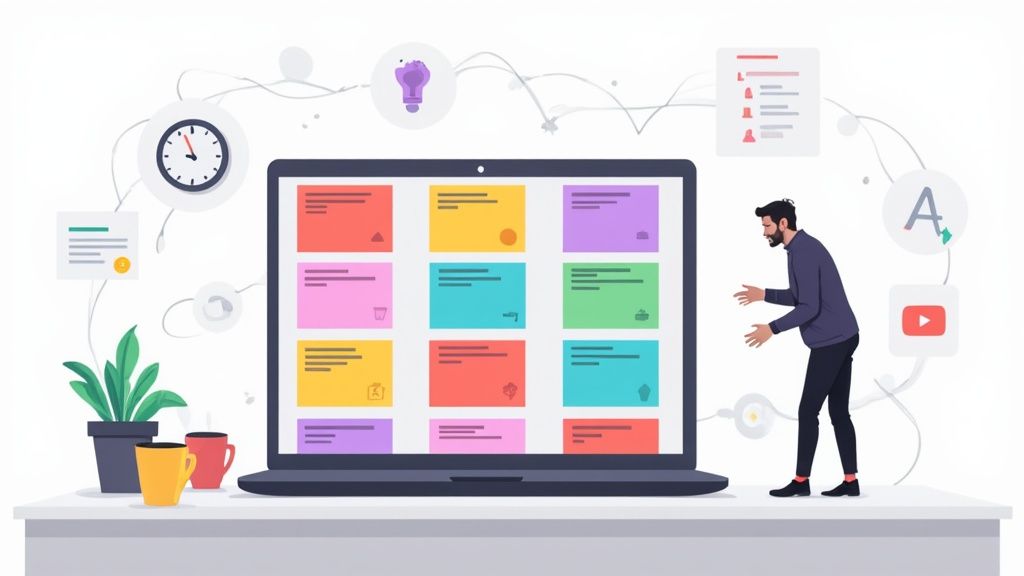OpusClip vs Manual Editing: A Strategic Path to 10x Content Velocity
How to scale short-form output, protect quality, and pick the right workflow for your team in 2025

Executive summary
Short-form video leads discovery in 2025, drawing the most audience attention to mobile. Platforms reward consistent publishing, and creators who can rapidly turn one video into many quality shorts have a clear advantage. AI tools like OpusClip accelerate the process, enabling you to produce a week's worth of Reels, Shorts, and TikToks in minutes. A brief human review ensures nuance, pacing, and brand polish, resulting in a fast but brand-faithful workflow.
OpusClip, accelerate your short-form workflow
Upload once, generate multiple vertical clips with captions and smart reframing, then do a quick human polish. Ideal for teams that want speed without giving up brand control.
- ClipAnything engine for finding hook moments
- Auto 9:16 reframing, multi-ratio exports
- Animated captions for silent feeds
- Speech enhancement and AI B-roll on Pro
I) The strategic imperative, why content velocity now decides growth
The industry-wide pivot to video is now a foundational reality underpinning digital operations. Executives should recognize that four-fifths of global internet traffic is routed through video. This is why short-form video campaigns must now be central to audience acquisition and brand competitiveness.
On the platform side, YouTube Shorts has reached roughly 200 billion daily views, a figure cited by YouTube’s CEO in mid-2025 and reported by multiple outlets. That alone is a clear demand signal for mobile-first, vertical content and a reason to keep publishing at a steady cadence.
A second structural reality, often ignored in planning, is that social video is usually consumed without sound. You need captions by default so your message survives the mute feed. Current roundups indicate that about three-quarters of Facebook video views are silent, and adjacent studies suggest the same behavior across platforms and age groups. If your edits ship without readable on-screen text, you give up a sizable portion of potential watch time.
If platforms reward frequency and viewers watch in silence, teams that post more often with captioned clips win. Velocity is now essential, not optional.
II) The manual bottleneck, where traditional repurposing runs out of road
If you have ever turned a 60-minute webinar or podcast into a week of vertical clips, you know the bottleneck. Even simple social shorts demand many small, sequential tasks:
- Scrub the source to find self-contained moments with clear hooks.
- Rough cut and arrange, then adjust pacing for mobile attention spans.
- Reframe for 9:16, keep faces centered, and add basic motion or text layers.
- Generate clean, readable captions that align with the platform's style.
- Fix audio issues, balance levels, and remove harsh noise.
- Color and export for each destination
Professional teams estimate 30 to 60 minutes of editing time per minute of finished content, even for basic material. More complex social shorts, requiring subtitles and on-brand visuals, take one to three hours per finished clip. This limits each producer to a narrow weekly output ceiling, constraining both campaign reach and analytics-driven optimization cycles.
Leaders should be aware of the additional risk associated with cognitive load. Editors spending hours searching for effective segments ship fewer versions, reducing total learning. Where digital success depends on high-frequency tests and iteration, these creative bottlenecks are now strategic liabilities.
III) Quantifying the gain, minutes not days
OpusClip’s value is easy to test, upload a video, let the AI generate clips, captions, and reframing, then do a quick human review. Instead of editor-days, you get drafts in minutes and focus on selection and polish.
To make the contrast clear, here is a practical time model for 10 shorts from one 60-minute video.
Table 1. Time to produce 10 clips
| Stage | Manual editing, typical | AI-assisted with OpusClip | What changes |
|---|---|---|---|
| Curation and selection | 1.5 to 3.0 hours | About 1 to 2 minutes of analysis | The AI locates hook moments you would have had to scrub for |
| Rough cut and assembly | 3.0 to 5.0 hours | Under 1 minute auto-clip | Timeline mechanics are automated |
| Reframe and captions | 3.0 to 5.0 hours | About 1 to 3 minutes | Vertical crop and styled captions are generated |
| Total for 10 clips | 9 to 18 hours | A few minutes to draft | Order-of-magnitude faster |
Exact ratios vary by brand standards, cloud processing replaces manual timeline work. You spend time on taste, context, and brand integrity rather than scrubbing and captioning.
IV) What the AI actually does well
1) Multimodal clipping that “sees” hooks
OpusClip’s ClipAnything engine analyzes visual, audio, and sentiment signals across the whole video. Instead of relying only on transcripts, it can find engaging beats in product demos, B-roll, and other low-dialogue segments. This is closer to a producer’s pass than a pure text search.
2) Instant mobile optimization
The tool auto-reframes subjects for 9:16, and can export in multiple aspect ratios for reuse. That eliminates a lot of crop and keyframe busywork that slows teams down.
3) Captions for the mute feed
Given that a large share of viewers watch without sound, animated captions with keyword highlights are not merely decorative, they are essential. OpusClip generates them by default and supports many languages, which is useful when you cross-post or target global audiences.
4) One-click speech enhancement
Audio issues ruin watch time. Background noise, echo, or sharp volume swings make people swipe away. OpusClip’s built-in audio enhancers remove noise, isolate voices, and adjust volume levels, so your clips sound professional without the need for an audio engineer. This small step is a big retention lever.
The essential question, does greater speed actually drive better outcomes
- More shots on goal. Moving from a few manual clips per week to ten or more AI-drafted clips increases testing and your chances of catching trends. Even small hit-rate gains accumulate quickly on large platforms.
- Better fit for silent, mobile viewing. Captioned, vertical clips align with how people actually consume feeds, which increases completion rates.
- Hook quality and watch time. OpusClip’s materials and case galleries emphasize time spent watching, tied to stronger openings, captions, and sound cleanup. Treat these as directional, still test and trust your analytics.
Caution on “Virality Scores”. The score is helpful for sorting, not omniscient. Reviews show mixed correlation between the score and performance, so test and let your data decide.
VI) Limits of automation, when humans must lead
- Context and meaning. Some segments rely on setup lines, tone, or a delayed punchline. AI may cut too aggressively and lose what makes the moment land.
- Captions and layering. If your source already has baked-in subtitles, auto captions can stack awkwardly. Switch styles or hide one set.
- AI B-roll. Automated cutaways can be helpful, but they are inconsistent. Always review for off-topic inserts.
Guidance, automate the repetitive ninety percent, then focus human effort on the final ten percent where differentiation happens.
VII) The hybrid workflow that scales quality
Step 1. Record once, repurpose many. Design long recordings to yield multiple stand-alone ideas. Add clear verbal hooks every few minutes, and leave breaths that give you edit points.
Step 2. Draft with OpusClip. Upload, let ClipAnything find candidates, generate captions, and reframe for vertical. Keep more than you will publish so you can test.
Step 3. Human quality pass.
- Fix any caption misreads or line breaks.
- Trim or extend for sense and comic timing.
- Align visuals with your brand kit, colors, fonts, intro and outro, safe areas.
- Replace any off-topic AI B-roll with purposeful cutaways.
Step 4. Export and finish where needed. If you need precise motion, transitions, or grading, export the XML to Premiere Pro or DaVinci Resolve and do a quick fine-tuning pass.
Step 5. Schedule and measure. Post across Shorts, Reels, TikTok, and LinkedIn, then track retention, completion, and saves.
Quality checklist before you post
- In the first three seconds, ask a question, reveal a tension, or promise a payoff.
- Captions are readable on a phone, and no text sits under platform UI.
- Audio is clean with comfortable loudness.
- One clear CTA at the end, follow, watch the full video, or join the list.
VIII) Plans, trials, and cost, what you actually get
- Free forever, 60 credits per month, up to 1080p exports, auto reframe, animated captions. Watermark stays, no full editor, exports expire after three days.
- Starter, $15 per month, 150 credits per month, full editor, virality score, no watermark, autoposting to Shorts, Reels, TikTok. Good for solo creators.
- Pro, $29 per month, annual pack with 3,600 credits up front, team workspace with two seats, custom fonts, multi-ratio exports, scheduler, export to Premiere Pro or Resolve. Unlocks speech enhancement and AI B-roll.
- Credits logic, about 1 credit per minute of original video.
- Trial gating, 7-day Pro trial lets you test the flow, some Pro features are excluded and trial exports are watermarked.
If you care about audio polish, brand fonts, and NLE export, Pro is the practical floor. If you only need watermark-free output and captions as a solo creator, Starter works. Free is ideal for proof of concept.
IX) Manual editing still wins in specific cases
- Strict brand systems. Precise typography, motion systems, logo choreography, and color pipelines benefit from a human-led timeline.
- Complex humor or narrative. When jokes depend on long setups, facial beats, or callbacks, human pacing decisions matter.
- High-stakes launches. Use AI for speed, then export to your NLE for a meticulous final pass.
Use AI to remove repetition, not responsibility.
X) A 14-day adoption sprint you can copy
Day 1 to 2, Source prep, choose two long videos with at least ten quotable moments each. Add timestamps of likely hooks if you already know them.
Day 3 to 4, Draft in OpusClip, upload both sources, generate 20 to 30 candidate clips. Start with the top 12 by score and intuition.
Day 5 to 6, Human pass, fix captions, swap odd B-roll, align fonts and colors, level audio, export three variants of your best idea.
Day 7 to 10, Publish and schedule, post one clip daily across platforms. Use the scheduler to stay consistent.
Day 11 to 14, Review and decide, compare watch time, completion, and saves against your manual baseline. Decide Starter or Pro based on NLE export, audio polish, and team seats.
If you save even 10 hours in this window and your billable rate is modest, the subscription pays for itself before you count incremental reach.
XI) Cost and ROI framing
- Time saved per month from AI drafting, assume 15 hours
- Your internal value of time, say $50 per hour
- Value created, $750
- Tool cost, $29 for Pro or $15 for Starter
Even if you cut the assumptions in half, the math still favors adoption. You also learn faster because you run more experiments.
XII) Bottom line and recommendations
- Adopt AI repurposing now, platforms reward frequency and prioritize silent, mobile viewing. Use captions and clean audio by default.
- Run a hybrid workflow. Let the tool draft many clips quickly, then spend a small amount of time refining context, pacing, and brand. Export to your NLE when a campaign needs exact polish.
- Choose plans by workflow. Free for proof, Starter for solo publishing without watermarks, Pro for teams that need speech enhancement, B-roll, scheduler, NLE export, fonts, and workspaces.
- Treat virality scores as suggestions. Publish, measure, and let your analytics tell the truth.
Affiliate link, using it helps support this content.





